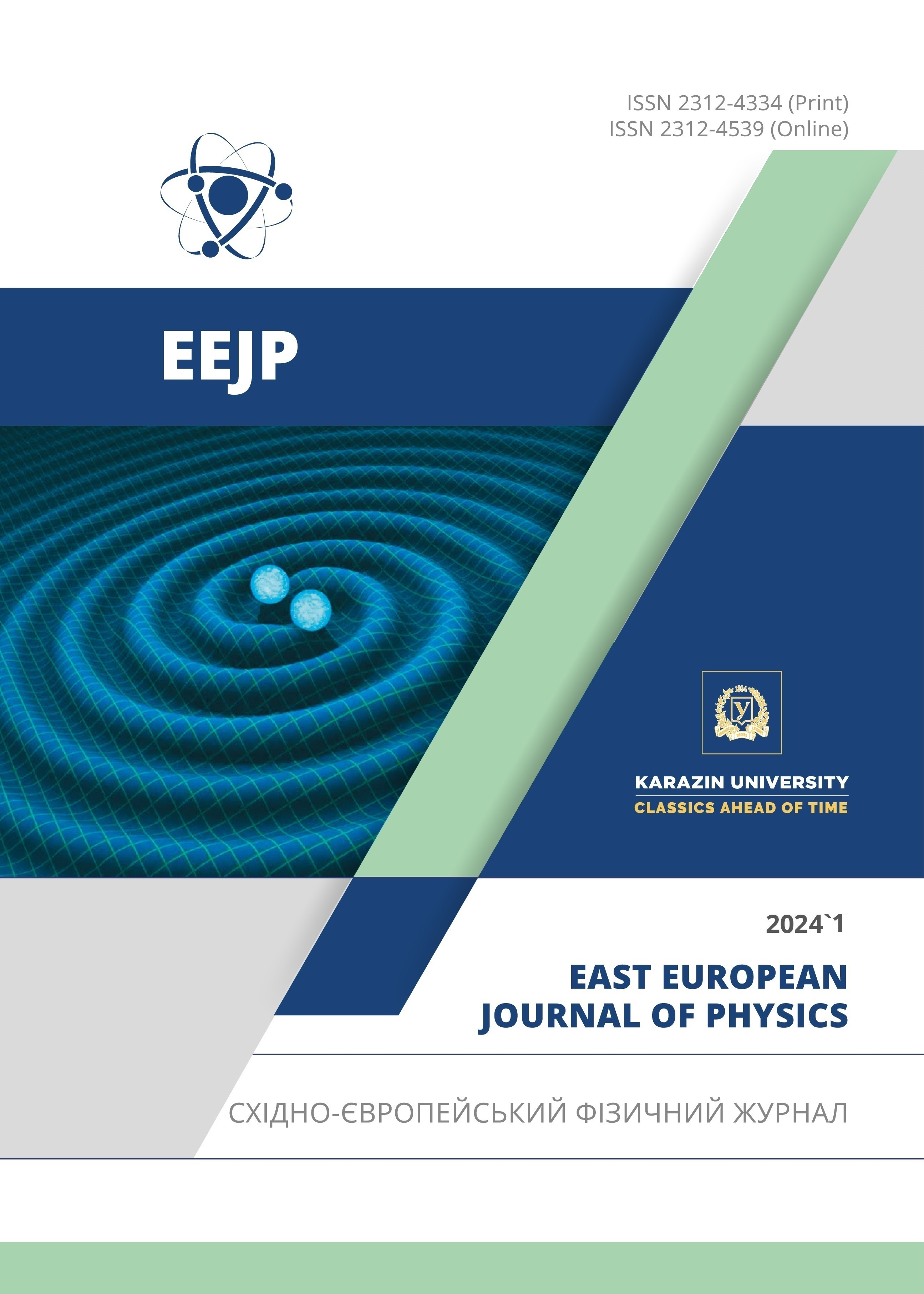Interaction of Very Thin Double-Layer Fibres with Electromagnetic Radiation. 1. Numerical Simulation
Abstract
Very thin conductive fibers, whose diameter is much smaller than the wavelength, strongly absorb and scatter electromagnetic radiation. The efficiency factors of absorption, scattering and radiation pressure of metal fibers with a diameter of several micrometers in the centimeter wavelength range reach several thousand. The absorption of electromagnetic radiation in two-layer fibers has been studied. In fibers with a metal core and a lossless dielectric cladding, the absorption is the same as in solid metal fibers. In lossy cladding fibers, strong absorption occurs when the fiber diameter is several nanometers. Fibers with a dielectric core and a metal cladding strongly absorb radiation when the thickness of the cladding is comparable to the thickness of the skin layer.
Downloads
References
H.C. van de Hulst, Light scattering by small particles, (Wiley, New York, 1981).
M. Kerker, The scattering of light and other electromagnetic radiation, (Academic Press, New York, London, 1969).
C.F. Bohren, and D.R. Huffman, Absorbing and scattering of light by small particles, (Wiley, New York, 1983).
R. Zhang, and E.M. Fedorov, Measurement of thing fiber diameter by the diffraction method, Conference TPU, 2, 153-158 (2018).
M. Kokodii, A. Natarova, I. Priz, and O. Biesova, “Express method of measurement of the refractive index of transparent fibers,” Ukrainian metrological journal, 3, 43-48 (2022). https://doi.org/10.24027/2306-7039.3.2022.269771
M. Kokodii, I. Zhovtonizhko, M. Barannik, and A. Natarova, “Computer method of measurement of the optical and color parameters of man hair,” Medical informatics and ingenery, 4, 30-38 (2022). (in Ukrainian).
W.M. Irvine, “Light scattering by spherical particles: radiation pressure, asymmetry factor, and extinction cross section,” Journal of the Optical Society of America, 55(1), 16-21 (1965). https://doi.org/10.1364/JOSA.55.000016
N.G. Kokodii, “Nature of resonances in a thick refracting cylinder during of an electromagnetic wave,” Optics and Spectroscopy, 72(2), 249-251 (1992).
V.M. Kuz’michev, N.G. Kokodii, B.V. Safronov, and V.P. Balkashin, “Values of the absorption efficiency factor of a thin metal cylinder in the microwave band,” Journal of Communications Technology and Electronics, 48(11), 1240-1242 (2003).
A. Akhmeteli, N.G. Kokodiy, B.V. Safronov, V.P. Balkashin, I.A. Priz, and A. Tarasevitch, “Efficient non-resonant absorption in thin cylindrical targets: experimental evidence for longitudinal geometry,” https://doi.org/10.48550/arXiv.1208.0066
A. Akhmeteli, N. Kokodii, B. Safronov, V. Balkashin, I. Priz, and A. Tarasevich, “Efficient non-resonant absorption of electromagnetic radiation in thin cylindrical targets: experimental evidence,” in: Proc. SPIE 9097, Cyber Sensing 2014, 90970H. https://doi.org/10.1117/12.2053482
N.G. Kokodii, A.O. Natarova, A.V. Genzarovskiy, and I.A. Priz, “Interaction between thin conductive fibers and microwave radiation,” Optical and Quantum Electronics, 55, 256 (2023). https://doi.org/10.1007/s11082-022-04389-x.
M. Kokodii, S. Berdnik, V. Katrich, M. Nesterenko, I. Priz, A. Natarova, V. Maslov, and K. Muntian, “Measurement of microwave radiation pressure on thin metal fibers,” Ukrainian Metrological Journal, 4, 45-50 (2021). (in Ukrainian). https://doi.org/10.24027/2306-7039.3.2020.216802
M. Kerker, and E. Matijevic, “Scattering of electromagnetic wave from concentric infinite cylinder,” Journal of the Optical Society of America, 51(5), 506-508 (1961). https://doi.org/10.1364/JOSA.51.000506
E.A. Velichko, and A.P. Nikolaenko, “Influence of a dielectric coating on the scattering of an electromagnetic wave by a metal cylinder,” Radiophysics and Radioastronomy, 18(1), 65-74 (2013). http://rpra-journal.org.ua/index.php/ra/article/view/1121/759
N.G. Kokodii, “Microwave radiation absorption in an ultrathin double-layer cylinder,” Journal of Communications Technology and Electronics, 51(2), 175–178 (2006). https://doi.org/10.1134/S1064226906020069
Copyright (c) 2024 Mykola G. Kokodii, Denys O. Protektor, Darya V. Gurina, Mykola M. Dybinin

This work is licensed under a Creative Commons Attribution 4.0 International License.
Authors who publish with this journal agree to the following terms:
- Authors retain copyright and grant the journal right of first publication with the work simultaneously licensed under a Creative Commons Attribution License that allows others to share the work with an acknowledgment of the work's authorship and initial publication in this journal.
- Authors are able to enter into separate, additional contractual arrangements for the non-exclusive distribution of the journal's published version of the work (e.g., post it to an institutional repository or publish it in a book), with an acknowledgment of its initial publication in this journal.
- Authors are permitted and encouraged to post their work online (e.g., in institutional repositories or on their website) prior to and during the submission process, as it can lead to productive exchanges, as well as earlier and greater citation of published work (See The Effect of Open Access).








